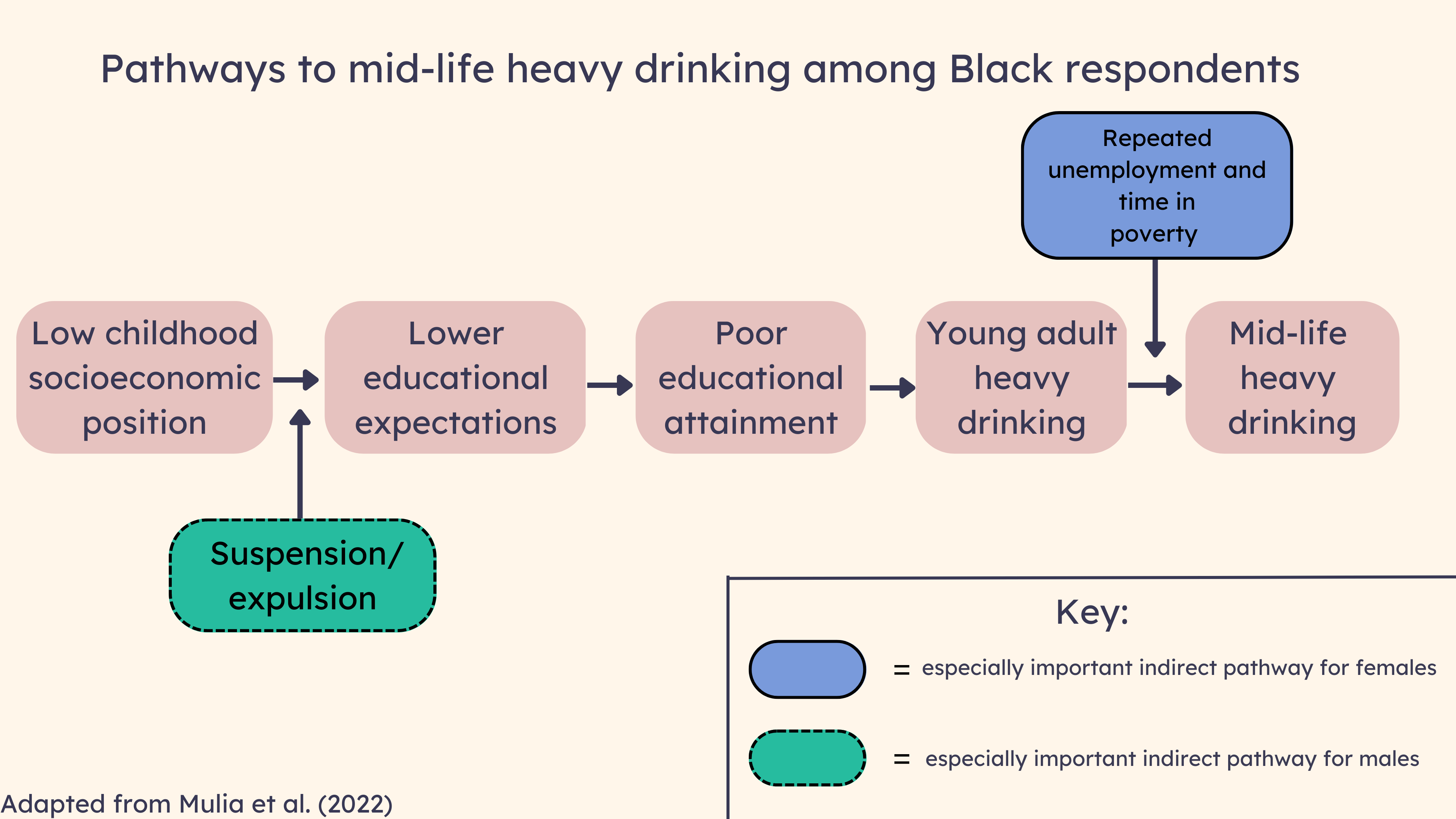Editor’s Note: Today’s review is part of our month-long Special Series on Pathways to Addiction. Throughout March, The BASIS is highlighting risk factors for and pathways to addiction.
Black adults in the United States are at greater odds of experiencing alcohol-related problems when compared to White adults, but what contributes to this disparity? Minoritized populations may experience greater negative health outcomes related to alcohol use due, in part, to racial disparities that plague our schools and economic systems. These negative outcomes become more easily observed during the middle of someone’s life and tend to be the result of childhood experiences, such as low socioeconomic status and low educational attainment. This week, as part of our Special Series on Pathways to Addiction, The DRAM reviews a study by Nina Mulia and colleagues that examined the pathway from low childhood socioeconomic position, through low level of educational attainment, and onward to mid-life heavy drinking among Black Americans.
What was the research question?
Does socioeconomic status and educational attainment experienced by Black children influence their drinking behavior as adults?
What did the researchers do?
The researchers used longitudinal data from the 1140 Black respondents to the (U.S.) National Longitudinal Survey of Youth 1979 (NLSY79) panel study. The data collection began in 1979 (when the respondents were 15-19 years old) and ended in 2012. The researchers’ primary outcome variable was the number of days out of the previous month when participants drank six or more drinks, representing mid-life heavy drinking. Their main predictors, parental educational attainment and time spent in poverty during adolescence, represented childhood socioeconomic status. Other variables included high school data, including number of suspensions and level of educational expectations, drinking behavior during young adulthood (ages 24-30) and mid-life (ages 42-52), highest level of education completed, adult poverty duration, and repeated instances of unemployment. The researchers controlled for family history of alcohol use, dual parent households at baseline, and respondent’s marital status and used a gender-stratified longitudinal path model to analyze the relationships between the variables.
What did they find?
Many respondents endured low socioeconomic status (43.4%), low educational expectations (56.7%), and high rates of school suspensions (39.5%). These characteristics were negatively correlated with educational attainment. The researchers observed significant pathways from low childhood socioeconomic status, through low educational attainment, to mid-life heavy drinking. There were some notable gender differences. For low-income Black boys, being suspended or expelled from school contributed to poor educational attainment, which then predicted heavy drinking in young adulthood and, eventually, in mid-life. School punishment was still an influential factor for Black girls, but living in poverty and being repeatedly unemployed was more influential in predicting mid-life heavy drinking for Black girls compared to Black boys. (see Figure).

Figure. This Figure depicts significant indirect pathways to mid-life heavy drinking among Black respondents. Click image to enlarge.
Why do these findings matter?
These findings suggest that the pathway to mid-life heavy drinking begins with low childhood socioeconomic status and moves through the child’s educational attainment, and onward through young adult heavy drinking among males and females and economic hardship among females. The researchers identified potential solutions, including school administrative practices and early substance use interventions. For instance, school administrators could implement restorative justice techniques rather than exclusion-based disciplinary practices in an effort to improve student’s perception of their abilities, academic and beyond. Other notable findings suggest that implementing interventions geared towards early screening for substance use and ways to maintain employment throughout young adulthood could also be effective in stopping the pathway to mid-life heavy drinking.
Every study has limitations. What are the limitations in this study?
The study only analyzed data from 1979-2012, which means the findings may not be generalizable to Black Americans born more recently. Also, the study results on mid-life heavy drinking might be conservative. The researchers defined “heavy drinking” as 6 or more drinks per day which exceeds the U.S National Institute for Alcohol Abuse and Alcoholism’s threshold of 4 drinks or more for men and 3 drinks or more for women. Lastly, the researchers did not examine neighborhood factors such as neighborhood poverty or alcohol availability, which could also be influential in determining substance use later on in life.
For more information:
The National Institute on Alcohol Abuse and Alcoholism has tips and resources for people struggling with problem drinking. For additional drinking self-help tools, please visit our Addiction Resources page.
— Nakita Sconsoni, MSW
What do you think? Please use the comment link below to provide feedback on this article.




